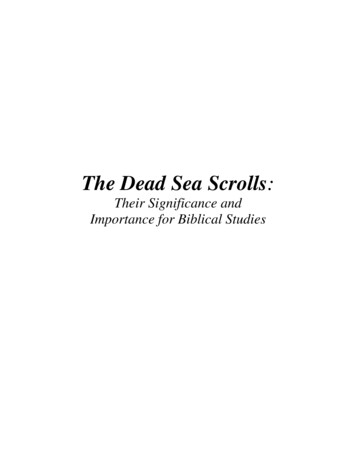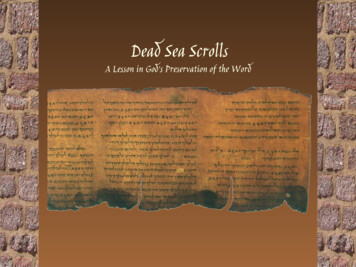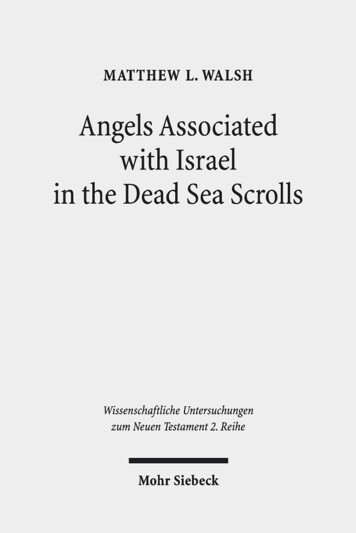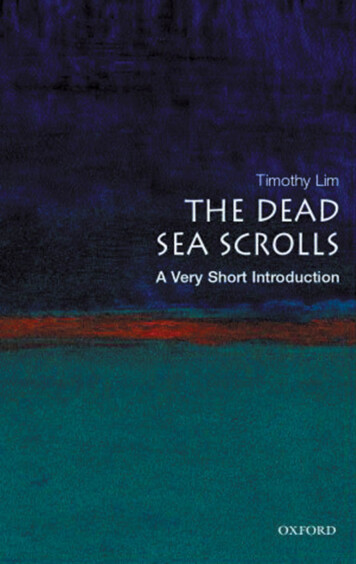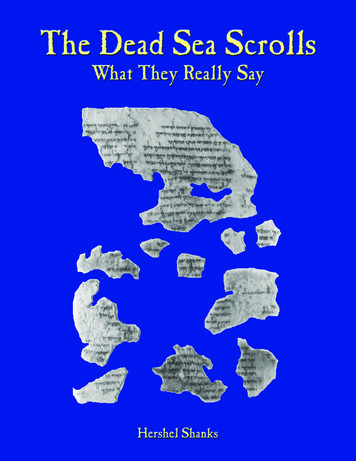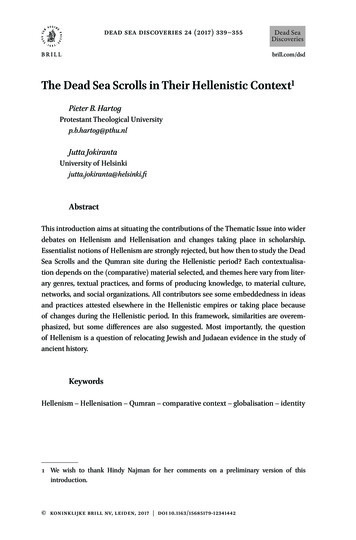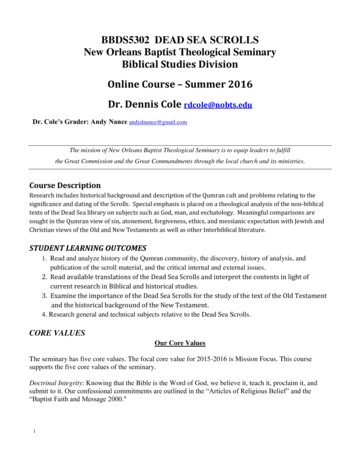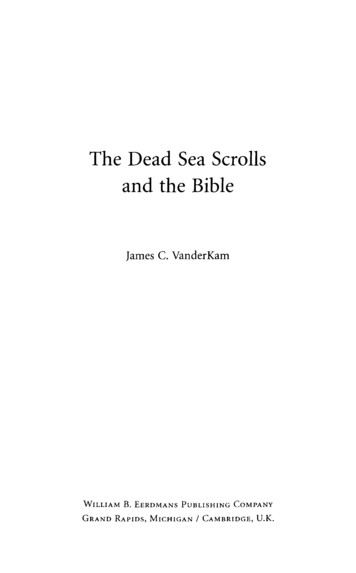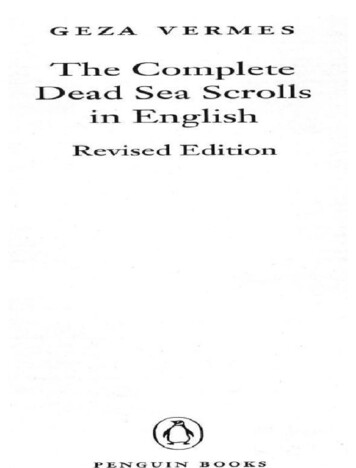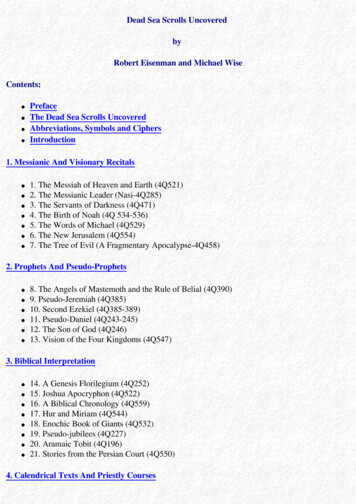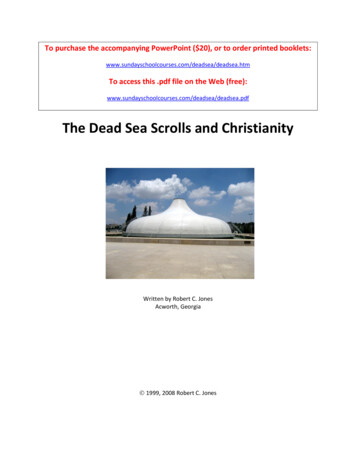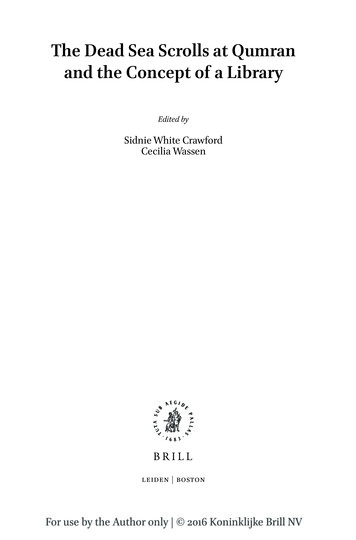
Transcription
The Dead Sea Scrolls at Qumranand the Concept of a LibraryEdited bySidnie White CrawfordCecilia WassenLEIDEN BOSTONFor use by the Author only 2016 Koninklijke Brill NV
ContentsIntroduction 1Part 1General StudiesThe Library of Qumran in Recent Scholarship 7Devorah DimantOn Being a ‘Librarian’: Labels, Categories, and Classifications 15Årstein JustnesPart 2The Greco-Roman ContextGreek and Roman Libraries in the Hellenistic Age 33Monica BertiThe Qumran “Library” and Other Ancient Libraries: Elements for aComparison 55Corrado MartoneIs Qumran a Library? 78Ian WerrettPart 3The Collection as a Whole and the Question of a LibraryThe Qumran Collection as a Scribal Library 109Sidnie White CrawfordThe Linguistic Diversity of the Texts Found at Qumran 132Stephen ReedFor use by the Author only 2016 Koninklijke Brill NV
vicontentsPlatesThe Ancient ‘Library’ of Qumran between Urban and Rural Culture 155Mladen PopovićThe Ancient “Library” or “Libraries” of Qumran: The Specter ofCave 1Q 168Stephen PfannPart 4Collections within the Collection: Specific Evidence for a Library?Calendars in the Qumran Collection 217Helen R. JacobusThe Aramaic Dead Sea Scrolls: Coherence and Context in the Libraryof Qumran 244Daniel A. MachielaPart 5Implications for the Identification of the Qumran Collectionas a LibraryThe Qumran Library in Context: The Canonical History and TextualStandardization of the Hebrew Bible in Light of the Qumran Library 261Armin LangeBibliography 281Index of Modern Authors 322Index of Biblical Literature 328Index of Texts from the Judean Desert 330Index of Other Ancient Sources 335For use by the Author only 2016 Koninklijke Brill NV
The Ancient “Library” or “Libraries” of Qumran:The Specter of Cave 1QStephen PfannIntroductionIn 2006, the 50th anniversary of the discovery of Cave 11Q passed by almostunnoticed. 2007 and 2008, however, saw a number of conferences devoted tothe 60th anniversary of the discovery of Cave 1Q. This is significant.The consensus view of the Dead Sea Scrolls, which links the caves, thescrolls and Qumran and takes them as a unitary find, was affected—we mighteven say, determined—by the discovery of Cave 1Q. From the moment the rockstruck the pot, this page of scholarly history was set. The scrolls, according tothe consensus view, are an Essene library hidden in caves near the Essene community’s center at Qumran. Philo, Josephus and Pliny provide the supportingevidence. Such is the force of the whole construct that it has become very difficult to even suggest an alternative scenario. The Yahad holds the field.But what if that stone had landed elsewhere? What if it had landed, forexample, in Cave 11Q? It seems highly unlikely that an Essene hypothesis forthis manuscript collection would ever have been proposed if only Cave 11Q hadbeen discovered. Other groups might well have been suggested instead.This essay argues that on the basis of differences in calendars, location,halakhic practice, liturgy, terminology, paleography, eschatology, and materialculture, the Dead Sea Scrolls do not represent the holdings of a single group.Although the Yahad character of Cave 1Q is clear, it is not clear for the othercaves. The calendars found among the Dead Sea Scrolls provide the most compelling evidence that the scrolls belong to more than one Jewish group of thelate Second Temple Period.After briefly retracing the history of scholarship that brought us to the current consensus, we will examine more closely the distinguishing features ofthe scroll collections which enable us to suggest links with groups other thanthe Essenes.The Allure of Cave 1QWhat is now known as Cave 1Q quickly became known as the “Grotte desmanuscrits” or the “Manuscripts Cave.” And indeed it was the “Scroll Cave” par koninklijke brill nv, leiden, 2016 doi 10.1163/9789004305069 011For use by the Author only 2016 Koninklijke Brill NV
The Ancient “ Library ” or “ Libraries ” of Qumran169excellence. It had it all: biblical scrolls, sectarian scrolls, commentaries, hymns,calendars, rule books, and descriptions of a future battle. Many pseudepigraphic works were discovered in their original languages for the first time.1There appeared to be a single copy of each of the essential volumes of alibrary belonging to one group. Eliezer Sukenik first suggested identifying theowners of these scrolls with a monastic Jewish order known as the Essenes,which were described by Philo, Pliny the Elder and Josephus. This identification was affirmed by Roland de Vaux and a long list of other scholars. Thoughsome remained skeptical, subsequent discoveries worked in favor of the growing consensus.In December 1951, four years after the discovery of Cave 1Q, Roland de Vauxconnected its manuscript remains to the nearby site of Khirbet Qumran whenhe found one of the unique cylindrical jars typical of Cave 1Q embedded inthe floor of the site. The power of this suggestion was such that, from thatpoint on, as each successive Judean Desert cave containing first century scrollswas discovered, they too were assumed to have originated from the site ofQumran. The original “Manuscripts Cave” was renamed “Cave 1Q.” Excavationsat Qumran appeared to confirm the communal and religious nature of theinhabitants, with numerous immersion pools, large community pantries, andabundant scribal implements, accompanied by a virtually all-male cemetery.All of this was considered compelling evidence for connecting this site notonly with the scrolls from the caves but also with the Essenes described byJosephus, Philo and Pliny.For scholars, Cave 1Q was the prototype. It became the cave against whichevery subsequently discovered cave was to be compared. As the number ofscrolls grew, the manuscript collection of the first cave, with its predominantlyYahad character, continued to be considered as typifying the central core ofwhat was perceived to have been a single, cohesive library spread among anumber of caves. This rather naïve presupposition became the governingassumption that underlies the specter of Cave 1Q.But, again, what if Cave 1Q had not been the first to be discovered? What ifCave 11Q had been discovered first? Or what if Cave 11Q was the only cave tohave been discovered? If one of these alternate scenarios had occurred, the keyelements which helped the first scholars to connect the scrolls to the site of1 The first publication of the scrolls was in 1950 and 1951 by M. Burrows of the AmericanSchools of Oriental Research (Isaiaha, Habakkuk Commentary; Community Rule). This wasfollowed by: E. Sukenik of Hebrew University (Isaiahb, Thanksgiving Hymns, War Scroll, 1955);R. de Vaux of the École Biblique et Archéologique Française (Chief Editor of the first fivevolumes of Discoveries in the Judean Desert, henceforth DJD); D. Barthélemy (biblical fragments) and J.T. Milik (non-biblical fragments, published in DJD 1).For use by the Author only 2016 Koninklijke Brill NV
170PfannQumran—and to identify the community as Essene—would be entirely lacking. The picture would be quite different.Two Very Different LibrariesFor example, if we only had the extant manuscripts from Cave 11Q, then:1.2.3.4.5.6.7.8.9.We would find no link to the Teacher of Righteousness or his community,so central to the scrolls of Cave 1Q and other Yahad-related caves.Our rule book, the Temple Scroll (three copies of which were found there),would focus on life at the Temple and not that of a disenfranchised, isolated wilderness community.Our liturgies would not include the Hodayot, which reflect the spirituality and piety of a persecuted and exiled community, but rather a set ofhymns connected with established Temple sacrifices.The priesthood would hold to an alternative version of the Psalms (with11QPsa and 11QPsb predominating), containing additional hymns andarranged in a different order.2The liturgical calendar would be structured around a series of pentecontad (50-day) cycles, with a number of additional extra-biblical feasts(11QTemple); rather than a calendar that is expressly limited to the commanded Biblical feasts as in 1QSerek ha-Yaḥad and 4QOtot.We would find a different eschatology, based upon a 490-year plan of history (following Jeremiah, as presented in 11QMelchizedek), and not a 390 40 year period (based upon Ezekiel 4, as presented in a copy of theDamascus Document from the Cairo Geniza).We would witness a greater acceptance of pseudepigraphic authorship,as in the case of the Temple Scroll.Nearly all of our manuscripts would be in beautiful, late Second TemplePeriod scribal hands, and not a wide range of scribal hands spanningthree centuries.As opposed to Cave 1Q, we would have no reason to suspect our group tobe the Essenes of Josephus, Pliny and Philo.32 Peter Flint has drawn attention to this alternate (both in content and order) shape of thePsalms, going so far as to call them, “the foremost representative of the Book of Psalms in theDead Sea Scrolls,” Dead Sea Psalms Scrolls and the Book of Psalms (Leiden: Brill, 1997), 223.3 Or for example, if we only had manuscripts from Masada, the only biblical manuscripts wewould find would be of the proto-Masoretic tradition, which are direct predecessors to ourpresent Masoretic Text, (i.e., of the Pharisaic, and later Rabbinic tradition). Furthermore,the priestly Songs of the Sabbath Sacrifice would be connected with a priestly contingentFor use by the Author only 2016 Koninklijke Brill NV
The Ancient “ Library ” or “ Libraries ” of Qumran171Cave One’s Influence on the Understanding of Subsequent CavesIn light of these observations, we must ask the question: why does the consensus view hold that all the scrolls are of Essene origin? Moreover, if what I amarguing is true, that the caves may well represent different groups, how is itthat the uniqueness of the manuscript finds of Cave 11 has gone unrecognizedto this point? The answer to this puzzle appears to begin with the subsequentdiscovery of caves in the vicinity of the first one, whose remains were too meager to suggest anything other than a connection with the first cave.Caves 2Q and 3QDuring the first three months of 1952, more scrolls were discovered in whatare now known as Caves 2Q and 3Q. If these caves alone had been discoveredin the Qumran cliffs, with three pocket-sized megillot—normally read by thelaity during specific festivals—and with no liturgies, the manuscript collection found therein would then have presented more of a lay character than apriestly one for the “Qumran Library.”Cave 2Q, located 100 meters south of Cave 1Q, contained more than 30 manuscripts. Notably, more than half were biblical books, including two megillot ofthe book of Ruth. And, like Cave 11Q (and Masada), it contained the remains ofa portion of the book of Ben Sira (in 11QPsa). At first glance, Cave 2Q was likeCave 1Q in that it contained fragments of such Aramaic documents as the NewJerusalem and the Book of Giants. However, these were subsequently judgedto be more widely circulating documents composed by groups other than theEssenes.4 More importantly, this second cave appears distinctly out of character for the Yahad in that it contained no texts authored by the communityitself, while containing Ben Sira, which was not found elsewhere in clearlyYahad-related caves (i.e., 1Q, 4Q, 5Q and 6Q). This should raise real questionssince it is well known that Ben Sira largely disagrees with key Yahad doctrines,5in particular, in its support for a lunar calendar as opposed to a solar one.Nonetheless, largely because of the proximity of the two caves, the scrolls ofCave 2Q were merely thought to have have been part of a single library.(whose presence is attested by ostraca at the site). There would be no reason to connectMasada with the Essenes of Josephus, Pliny and Philo and a completely different scenariowould have emerged.4 Cf. Florentino García Martínez, Qumran and Apocalyptic: Studies on the Aramaic Texts fromQumran (Leiden: Brill, 1992), 113–15.5 Throughout this paper, the word “doctrine” is used to designate teachings bearing on behavior and thought. This is utilized in an effort to avoid the term “halakha,” which is a groupspecific term deriving from Pharisaic tradition.For use by the Author only 2016 Koninklijke Brill NV
172PfannCave 3Q, located 1.5 km north of Cave 1Q and with only 15 identifiable scrolls,provided various biblical books, in particular a megilla of Lamentations. Therewas also what appeared to be the beginning of a commentary on the bookof Isaiah. This was enough to convince many scholars that this was nothingless than another Yahad pesher on the prophets. The fact that there were noobvious scrolls of the Yahad, as there were in Cave 1Q, did not prompt de Vauxand his team to hypothesize another group as the source of this cave’s scrolls.Cave 3Q also contained an odd copper treasure map (the Copper Scroll) whosecontents would remain concealed for several years. At this stage, neither thiscopper scroll nor the lack of Yahad documents nor the cave’s distance fromCave 1Q was enough to earn for Cave 3Q its own unique profile.6In the eyes of de Vaux’s original team,7 there still were no compelling reasonsto disbelieve that the scrolls from the first three caves were closely linked. Theunusual scrolls were simply anomalies which would serve to further enlightenus as to the character of the group who produced them. Six months later, anypossible question concerning the scarcity of evidence linking these two cavesto the Yahad and Cave 1Q was quickly dismissed when four additional caveswere discovered which provided strong links to both Cave 1Q and the Yahad.Caves 4Qa, 4Qb, 5Q, and 6QThe massive scroll finds yielded by clandestine operations of the Bedouinand official excavations of de Vaux’s team during September 1952 amountedto more than 15,000 additional scroll fragments. These came from two caves,4a and 4b, whose contents were too mixed to distinguish by the time theyarrived at the museum, and so together were called “Cave 4Q.” These meager,larva-eaten fragments were eventually sorted by an expanded team of nineinternational scholars8 who were handpicked to carry out the painstaking and6 However, somewhat later, Chaim Rabin, “Alexander Jannaeus and the Pharisees,” JJS 7 (1956):3–11, and John Allegro, The Treasure of the Copper Scroll (2nd rev. ed.; New York: Anchor Books,1964), posited that the Copper Scroll was actually a product of the Zealots in Jerusalem andthat the treasures mentioned there were from the Jewish Temple. Nevertheless, de Vaux andHarding, standing by their initial assessment that the caves were connected with the site,were forced to consider the treasures described by the scroll to be fictitious based upon the(circular) reasoning that the riches of the Copper Scroll did not match the lifestyle of theEssenes at Qumran.7 From France: R. de Vaux (Chief Editor and Archaeologist), P. Benoit (Murabba‘at, Greek andLatin texts); Germany: A. Grohmann (Murabba‘at, Arabic texts); Poland: J.T. Milik (CopperScroll from Cave 3; Cave 5; Murabba‘at, Hebrew and Aramaic texts).8 As opposed to the earlier team, which was primarily from France, de Vaux decided to forma small but wide-ranging international team. From Poland: J.T. Milik (Targums, Mezuzas,For use by the Author only 2016 Koninklijke Brill NV
The Ancient “ Library ” or “ Libraries ” of Qumran173laborious task of sorting and editing the expanding list of manuscripts. Thetally from Cave 4Q rose from 200 to 300, then 400, and finally reached over500 manuscripts.The contents of these ancient scrolls were much more diverse than thosepreviously discovered. However, due to the presence of additional copies of thesame scrolls found in Cave 1Q such as the Rule of the Community, Hodayot,the War Scroll and various commentaries, these new discoveries only helpedto confirm the assumption that just one voluminous Essene library existed inthe cliffs of Qumran, distributed among the numerous caves. Despite the growing distance, the scrolls stored in caves up to two miles apart were still considered to be accessible to those living at the site. If a certain scroll were required,so the argument went, it would have taken a young librarian merely an hour ortwo in the arid desert to fetch it from one of the caves.Alternatively, it was suggested that the diversity of documents in Cave 4Qand their condition (including damaged and unsewn sheets) might indicatethat it comprised a burial place for worn-out scrolls, or a repository for personal scrolls contributed by newcomers to the Essene community. Whateverexplanation could be proposed for the massive and diverse contents of thesenew caves, it seemed to be more compelling to accept the broadened libraryas reflecting the authorship and thinking of a single group than to propose ageneral library housing the works of a varied groups. The learning and doctrineof the Essenes continued to be depicted as relatively conservative and narrowin its scope (although Josephus depicted the Essenes as being widely read),9despite the diverse character of manuscripts in these caves.Phylacteries in DJD 6, Apocrypha, Pseudepigrapha and other nonbiblical texts); UnitedKingdom: J. Allegro (parabiblical texts, DJD 5) and J. Strugnell (non-biblical texts); UnitedStates: F.M. Cross, Jr. (biblical texts), P. Skehan (Paleo-Hebrew and Greek biblical texts);Germany: C. Hunzinger (War Scroll, left team later); France: R. de Vaux (Chief Editor andArchaeologist), J. Starky (Aramaic texts), M. Baillet (miscellaneous papyrus manuscripts andWar Scroll). For more detail see Julio Trebolle Barrera, The People of the Dead Sea Scrolls: TheirWritings, Beliefs and Practices (with F. García Martínez, trans. W.G.E. Watson; Leiden: Brill,1995), 21.9 “They apply themselves with extraordinary zeal to the study of the works of theancients. . . . There are some among them who, trained as they are in the study of the holybooks and the [sacred] writings, and the sayings of the prophets, become expert in foreseeing the future: they are rarely deceived in their predictions” (War 2.8.136, 159). Concerningthe relatively eclectic and mixed nature of Cave 4Q see C. Hempel and cited related studiesin Charlotte Hempel, The Qumran Rule Texts in Context: Collected Studies, esp. Ch. 5, “TheDistinctive Elements in the Character of Cave 4,” (Tübingen: Mohr Siebeck, 2013), 311–37.For use by the Author only 2016 Koninklijke Brill NV
174PfannThe contents of nearby Cave 5Q were in most ways similar in content andcharacter to those of Cave 4aQ and 4bQ, and seem rightly to be classified withthose caves as a unit. Cave 6Q, on the other hand, was located in the hard limestone cliffs to the west and yielded fragments of scrolls that had been writtenprimarily on papyrus instead of parchment. In this respect, Cave 6Q is uniqueamong the caves found in the vicinity. It also included a copy of the DamascusDocument which linked it doctrinally with other Yahad documents, althoughthe contents of Cave 6Q appear to be largely directed toward the concerns ofa lay audience.10The growing consensus viewed the discovery of such books as Enoch andJubilees as “external” literature which had nevertheless been deemed acceptablereading within the Essene community. The team’s conclusion that the scrollsstill constituted a single library gained plausibility from the presence of booksauthored by the Essenes themselves. Thus far only the collections of manuscripts from caves 2Q and 3Q lacked the characteristic Yahad documents, butthe sum of the scrolls found in these caves, approximately fifty in toto, was considered too small to be significant in challenging the constitution of the library.The Meager Remains of Caves 7Q, 8Q, 9Q and 10QDuring the spring of 1955, de Vaux turned his attention to some collapsedcaves at the southern end of the marl terrace upon which the site of Qumranwas built (Caves 7Q, 8Q, 9Q and, on the peninsula to the west, Cave 10Q). Thecontents of these caves were meager compared with what once existed there.However, these still added evidence that might suggest that there was a broaderpicture awaiting to be seen. For example, cave 7Q uniquely contained remnants of papyrus scrolls written only in Greek, normally linked with HellenisticJudaism. Yet this was still deemed to be part of the same “Qumran Library.”Again, the scroll content of these caves was considered too limited in size tosuggest that more than a single group was responsible for the manuscripts inall of the caves discovered thus far.What is critical to note here is that the initial surveys, assessments and conclusions concerning the Dead Sea Scrolls, which appeared at the end of the1950s, were produced by members of the original team without the benefit of10The Damascus Document directs its attention primarily to issues which would concern the lay membership of the community. That, along with the existence of a pocketscroll of the book of Canticles (Song of Songs), generally associated with laypersons andread at the Feast of Passover, would be consistent with a lay library. Cf. Stephen Pfann,“Reassessing the Judean Desert Caves: Libraries, Archives, Genizas and Hiding Places,”Bulletin of the Anglo-Israel Archaeological Society 25 (2007): 155–59.For use by the Author only 2016 Koninklijke Brill NV
The Ancient “ Library ” or “ Libraries ” of Qumran175the data from Cave 11Q or other Judean wilderness sites. These publications byJ.T. Milik (1957), F.M. Cross (1958), and R. de Vaux (1959)11 were highly influential in forming a consensus view, unifying the scrolls, the caves and the sites ofQumran and Ein Feshkha in their entirety around a single group, the Essenes.The result led to the view of a single, unified library dispersed among the elevencaves.12 A chapter in Milik’s monograph treated the scrolls as “The QumranLibrary.” Cross named his volume The Ancient Library of Qumran. Given thematerials available at the time, (i.e., excluding the manuscripts of Cave 11Q),the evidence appeared to lend general support to this unified view. Althoughexpanded editions and translations of these books appeared in the few yearsfollowing, little was added to modify the basic hypothesis. Also, the stipendsprovided for the efforts of the original team abruptly ceased with the death oftheir chief supporter, J.D. Rockefeller, in 1961, forcing the scholars to concentrate their attention on fulfilling other academic responsibilities.1112Jozef T. Milik, Ten Years of Discovery in the Wilderness of Judaea (Studies in BiblicalTheology 26, London: SCM, 1959). Frank M. Cross, The Ancient Library of Qumran (1st ed.1958; 3rd ed. Sheffield: Sheffield Academic Press, 1995). Roland de Vaux, Archaeology andthe Dead Sea Scrolls: The Schweich Lectures of the British Academy, 1959 (rev. ed.; London:Oxford University Press, 1973).The initial theory, however, was not that the scrolls constituted a library. While unaware ofany connection with a local site, Sukenik initiated the view that the contents of the firstcave were that of “a geniza, i.e., concealed after falling into disuse, in order to prevent theirprofanation.” Eliezer L. Sukenik, The Dead Sea Scrolls of the Hebrew University (Jerusalem:Magnes Press, 1955), 22–24. This identification as a geniza was at first considered (1949)but then strongly dismissed by de Vaux after his initial excavations at Qumran, whichhe believed conclusively connected the site with the caves. Sukenik died in January 1953without formulating a reaction to the new evidence from the site of Qumran or the subsequent caves 4Q, 5Q and 6Q. Del Medico shared Sukenik’s opinion and further developed Sukenik’s theory by disassociating the caves from the site of Qumran, believingthat all subsequent caves found in the immediate vicinity were also genizas. Henri E.del Medico, The Riddle of the Scrolls (trans. H. Gardner, London: Burke Publishing Co.,1958). Godfrey R. Driver then upheld this idea in his book The Judean Scrolls: The Problemand a Solution (Oxford: Blackwell, 1965). The geniza theory was then challenged by Milikin favor of a single unified library. Cf. Milik, Ten Years, 20. Yigael Yadin (Sukenik’s son)also accepted the unified library view to such an extent as to include the contents ofcave 11Q: “True, it (the Temple Scroll) was discovered in one of the Qumran caves, and,together with other copies, it was part of the library of the sect.” Yigael Yadin, The TempleScroll (Jerusalem: Steimatzky, Ltd., 1985), 230. More recently, a geniza theory has oncemore been asserted, especially for cave 1Q; cf. Joan E. Taylor, “Buried Manuscripts andEmpty Tombs: The Qumran Genizah Theory Revisited” in ‘Go Out and Study the Land’( Judges 18:2): Archaeological, Historical and Textual Studies in Honor of Hanan Eshel (ed.A.M. Maeir, J. Magness, and L.H. Schiffman; Leiden/Boston: Brill, 2012), 269–315.For use by the Author only 2016 Koninklijke Brill NV
176PfannCave 11QIn January 1956, another cave of major significance was found when Bedouinnoticed a bat flying in (or out) of a small hole in the cliff face, 2 km north of thesite and 1 km north of Cave 1Q. The cave produced a number of substantiallypreserved scrolls which could be unrolled, similar in many ways to the condition of the scrolls of Cave 1Q.Of the 31 manuscripts found, 30 were quickly purchased by the trustees ofthe Palestine Archaeological Museum with the intention that the scrolls wouldremain unstudied until appropriate agencies would reimburse them for theirinitial investment. Nearly six years elapsed. During October 1961 the first scroll,11QPsalmsa, was released for publication. The Targum of Job was released inDecember of the same year and all but two of the scrolls were released a yearlater. The remaining scrolls were acquired only in 1967, including the TempleScroll and the Paleo-Hebrew Leviticus scroll (unrolled only in 1970).13Due to this procedure the scrolls of Cave 11Q were distributed among scholars who were not part of the original team.14 Aside from widely distributedscrolls of the Bible and Jubilees, only two texts appeared to convincinglylink this cave with the others: the Songs of the Sabbath Sacrifice and the NewJerusalem (which later proved not to be connected with the Yahad).15The lone doctrinal text found in Cave 11Q was the Temple Scroll (three copieswere eventually identified) as well as other liturgical works. As noted above,the contents of this set of scrolls should have raised questions about connecting this cave with the rest of the “library” since the Temple Scroll presents therules and liturgies of a priestly society serving within a temple precinct, not inthe expanses of the desert, as was the case with the Yahad.1613141516James A. Sanders, The Psalms Scroll of Qumrân Cave 11 (11QPsa) (DJD 4; Oxford, 1965),vii–viii. Johannes P.M. van der Ploeg, Adam S. van der Woude, and Bastiaan Jongeling,Le Targum de Job de la grotte XI de Qumrân (Leiden: Brill, 1971), Introduction. David N.Freedman and Kenneth A. Mathews, The Paleo-Hebrew Leviticus Scroll (Winona Lake:ASOR/Eisenbrauns, 1985), 1–3.I.e., not Milik, Cross, Skehan, Allegro, Strugnell, Starcky, Barthelemy or Baillet.Subsequently, other scrolls have been suspected to be of sectarian origins (e.g.,11QMelchizedek, 11QSefer HaMilhama, 11QS?, about which see below). However, no scrollsamong the Cave 11Q collection have been proven with any certainty to be Yahad in origin.Yadin took the position that the Temple Scroll could be sectarian in both the broader sense,as representing a wider movement, and in the narrower sense, as being doctrinally similar to the Qumran sect/Essenes. Yigael Yadin, The Temple Scroll (3 vols.; Jerusalem, IsraelExploration Society, 1983), 1: 398–99. Perhaps the most surprising addition to the singlelibrary theory came from the excavations of Masada, 100 km south of Qumran. From lateNovember 1963 until the spring of 1965, fifteen literary scrolls, roughly contemporary withFor use by the Author only 2016 Koninklijke Brill NV
The Ancient “ Library ” or “ Libraries ” of Qumran177The Conclusion of an Ongoing TrendBy the time the 1960s arrived, scholars, driven by this widely-accepted andostensibly reasonable notion, did not try to distinguish potentially differentgroups represented among the caches of scrolls and material remains of theindividual caves and sites. Rather, the academic world focused its attentionon trying to create a synthetic, cohesive paradigm in which they continued toregard the scrolls as reflecting the perspective of a single group.Queries Raised by a New Generation of ScholarsAs a new generation of scholars was added to the team studying the scrolls, theview of a unified “Qumran Library” gradually started to unravel. Increasingly,they found evidence for diversity and even polemics between the various scrolls. Scholars who studied religious law, including L. Schiffman andJ. Baumgarten, identified irreconcilable differences between the Temple Scrolland Miqṣat Maʿaśe ha-Torah (henceforth MMT) over against the other DeadSea Scrolls.17 Scholars specializing in liturgical prayers increasingly discoveredmore diversity among those texts as well. This includes those who worked withthe Songs of the Sabbath Sacrifice, once considered to be a key Yahad composition, who became convinced that it does not actually fit Qumran’s Yahad.18With the benefit of hindsight, it is tempting to ask why scholars were reluctant to question the governing assumption of a single library in the face ofthe wide dispersal of caves in the Judean wilderness and the significant differences in the doctrines, calendars (discussed more fully below) and eschatology1718those of Qumran, were uncovered at Masada by Yadin and his team. Only a copy of theSongs of the Sabbath Sacrifice and a Qumran-like fragment could possibly link these manuscripts to the Qumran community. Nevertheless, based upon the initial assumptions ofthe origin
The consensus view of the Dead Sea Scrolls, which links the caves, the scrolls and Qumran and takes them as a unitary find, was affected—we might even say, determined—by the discovery of Cave 1Q. From the moment the rock struck the pot, this page of scholarly history was set. The scrolls, according to
